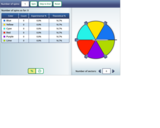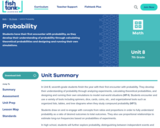
Students will be able to design and conduct their own simulation to determine the probability of an event.
- Subject:
- Mathematics
- Material Type:
- Lesson Plan
- Provider:
- BetterLesson
- Date Added:
- 12/01/2022

Students will be able to design and conduct their own simulation to determine the probability of an event.

Students will be able to see the relationship between theoretical probability and experimental probability by computing both at the same time.

This lesson [2:18] shows how to calculate the desired outcomes in a probability experiment or problem.

This lesson [3:31] shows how to calculate the desired outcomes in a probability experiment or problem. It is 2 of 8 in the series titled "Counting Desired Outcomes."

Discusses the difference between theoretical and experimental probability and how to use what information you have in order to estimate the likelihood of a given outcome. [6:55]
Khan Academy learning modules include a Community space where users can ask questions and seek help from community members. Educators should consult with their Technology administrators to determine the use of Khan Academy learning modules in their classroom. Please review materials from external sites before sharing with students.

Get independent practice working with theoretical probability. Each incorrect response gets a text box explanation and another try. Correct responses are confirmed.

An interactive game for learning theoretical vs experimental probability.

Introduction to Probability is a resource that provides assessment and teacher tutorials that focus on mathematic concepts such as probability, outcomes, events, probability distribution, laws, values and odd.

An introduction to probability through the example of flipping a quarter and rolling a die. [8:18]
Khan Academy learning modules include a Community space where users can ask questions and seek help from community members. Educators should consult with their Technology administrators to determine the use of Khan Academy learning modules in their classroom. Please review materials from external sites before sharing with students.

Think about what probabilities really mean. What does a probability of 0 mean? How about 1? [8:51]
Khan Academy learning modules include a Community space where users can ask questions and seek help from community members. Educators should consult with their Technology administrators to determine the use of Khan Academy learning modules in their classroom. Please review materials from external sites before sharing with students.

In this video, explore the odds of winning the Powerball lottery and learn what few people realize about their chances of winning: they are miniscule. In the accompanying classroom activity, students create simple lottery models to help them understand the probability of compound events. Though the probability of success at these experiments is better than that of Powerball, students will quickly see that the odds of winning any lottery-type game are seldom in their favor.

Practice making predictions with probability with these problems.
Khan Academy learning modules include a Community space where users can ask questions and seek help from community members. Educators should consult with their Technology administrators to determine the use of Khan Academy learning modules in their classroom. Please review materials from external sites before sharing with students.


Samples and ProbabilityType of Unit: ConceptualPrior KnowledgeStudents should be able to:Understand the concept of a ratio.Write ratios as percents.Describe data using measures of center.Display and interpret data in dot plots, histograms, and box plots.Lesson FlowStudents begin to think about probability by considering the relative likelihood of familiar events on the continuum between impossible and certain. Students begin to formalize this understanding of probability. They are introduced to the concept of probability as a measure of likelihood, and how to calculate probability of equally likely events using a ratio. The terms (impossible, certain, etc.) are given numerical values. Next, students compare expected results to actual results by calculating the probability of an event and conducting an experiment. Students explore the probability of outcomes that are not equally likely. They collect data to estimate the experimental probabilities. They use ratio and proportion to predict results for a large number of trials. Students learn about compound events. They use tree diagrams, tables, and systematic lists as tools to find the sample space. They determine the theoretical probability of first independent, and then dependent events. In Lesson 10 students identify a question to investigate for a unit project and submit a proposal. They then complete a Self Check. In Lesson 11, students review the results of the Self Check, solve a related problem, and take a Quiz.Students are introduced to the concept of sampling as a method of determining characteristics of a population. They consider how a sample can be random or biased, and think about methods for randomly sampling a population to ensure that it is representative. In Lesson 13, students collect and analyze data for their unit project. Students begin to apply their knowledge of statistics learned in sixth grade. They determine the typical class score from a sample of the population, and reason about the representativeness of the sample. Then, students begin to develop intuition about appropriate sample size by conducting an experiment. They compare different sample sizes, and decide whether increasing the sample size improves the results. In Lesson 16 and Lesson 17, students compare two data sets using any tools they wish. Students will be reminded of Mean Average Deviation (MAD), which will be a useful tool in this situation. Students complete another Self Check, review the results of their Self Check, and solve additional problems. The unit ends with three days for students to work on Gallery problems, possibly using one of the days to complete their project or get help on their project if needed, two days for students to present their unit projects to the class, and one day for the End of Unit Assessment.

Students collect and analyze data for their unit project.Students are given class time to work on their project. Some students may choose to use the time to collect data (if their project is an experiment based on experimental probability), while others will use the tools (spinners, coin toss, number cube, etc.) to collect their data. Students should use the time to analyze their data, finding the theoretical (if possible) probability and comparing it to the experimental results.Key ConceptsStudents will apply what they have learned about probability to work on their project, including likelihood of events, determining theoretical and experimental probability, comparing results to calculations, and using simulations to establish probability.Students may also use data analysis tools to discuss their results.Goals and Learning ObjectivesComplete the project, or progress far enough to complete it outside of class.Review concepts of probability (simple probability, compound events, experimental vs. theoretical probability, simulations).

Students critique and improve their work on the Self Check, then work on additional problems.Key ConceptsStudents apply what they have learned to date to solve the problems in this lesson.Goals and Learning ObjectivesApply knowledge of probability to solve problems.Determine theoretical probability.Predict expected results.

Students are able to to visualize the difference between theoretical and experimental probabilities with this computer based tool.

Students have their first encounter with probability, as they develop their understanding of probability through calculating theoretical probabilities and designing and running their own simulations.

This lesson explains how the Law of Large Numbers works in probability and how it can be used to find predictable patterns in data. Includes downloadable study guide with exercises - guide also covers other topics. [6:24]

Looks at a marble experiment to see how the anticipated probability compares to the actual outcome. [7:02]
Khan Academy learning modules include a Community space where users can ask questions and seek help from community members. Educators should consult with their Technology administrators to determine the use of Khan Academy learning modules in their classroom. Please review materials from external sites before sharing with students.